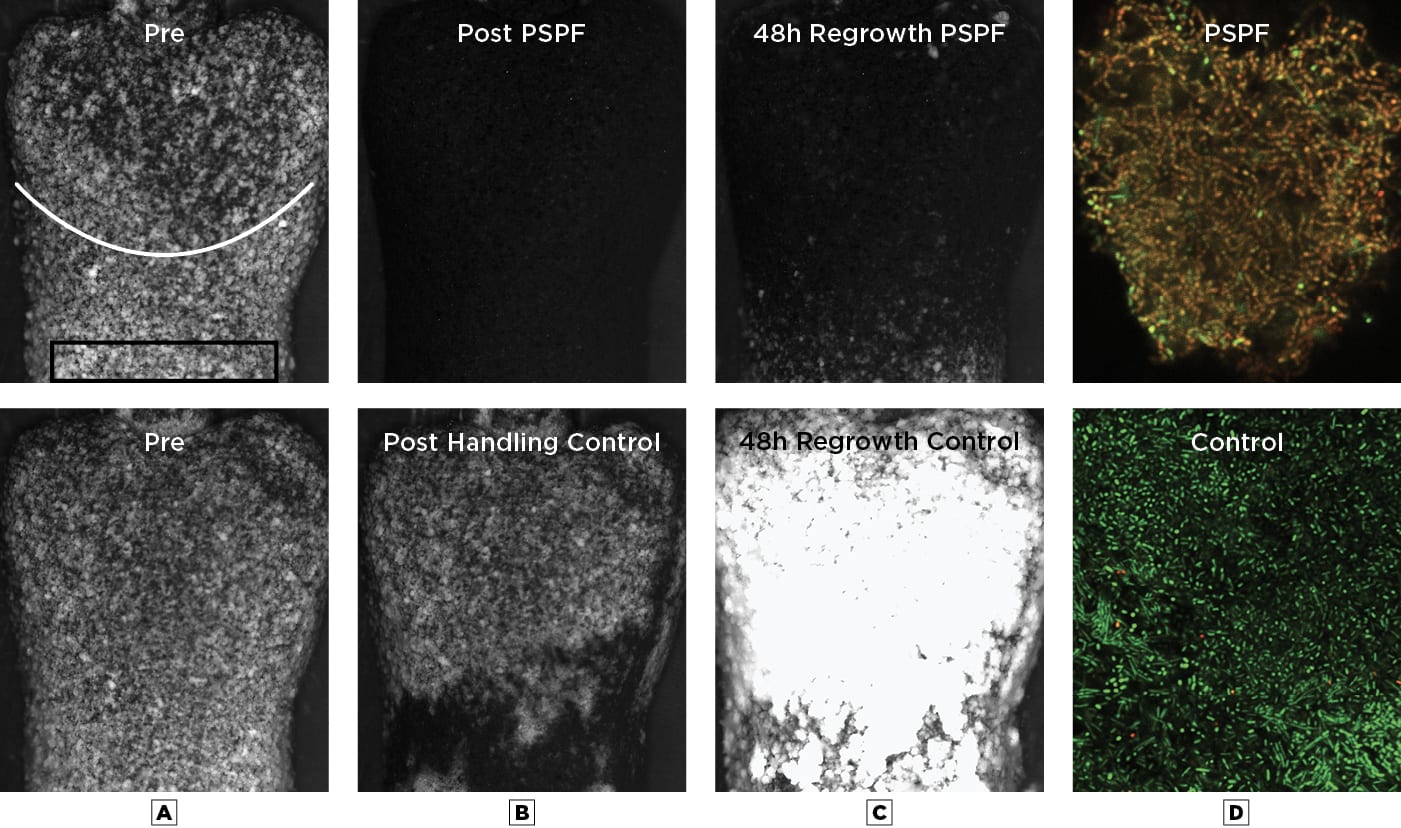Bart Gottenbos, MSc, PhD; Anandh Balakrishnan, PhD; Loes van de Kamp-Peeters, BASc; and Bart Keijser, PhD
Introduction
The Philips® Sonicare® Power Flosser (PSPF) is highly effective in reducing gum disease.1 Next to effective supragingival cleaning, this may be partially driven by subgingival cleaning. This in vitro study aimed to assess the effectiveness of the PSPF in removing biofilm from a model periodontal pocket up to 6 mm deep and to investigate the taxonomic composition of biofilm regrown after use of the PSPF.
Materials and Methods
Periodontal biofilm was grown on surrogate tooth surfaces according to the method used by Janus et al,2 starting from a pooled saliva-plaque mixture using artificial saliva supplemented with 10% fetal calf serum. The tooth surfaces were modeled as a buccal half (B, n = 10/group) or distal approximal half (D, n = 10/group) of adult molars and 3D printed using black polyamide 12 material. Initially, an anaerobic atmosphere was maintained for 24 hours to support anaerobe colonization. Subsequently, a microaerophilic atmosphere was used for the remainder of the biofilm growth as it more closely resembled the localized conditions within a periodontal pocket.3 After 48 hours of biofilm growth, the surrogate tooth surfaces were placed in an in vitro model that simulated a row of molars having interproximal spaces and rubber gums shaped to create up to 6 mm deep pockets.
One group of biofilm-coated surfaces was exposed to a cordless PSPF 3000 (clean mode, setting 3) with Quad Stream nozzle according to directions for use. The other group of surfaces was left untreated as a control. The biofilm thickness within the deepest 2 mm of the pocket was analyzed using cross-polarized light microscopy and optical coherence tomography. Subsequently, the surrogate tooth surfaces were once again placed in growth media. After 48 hours of biofilm regrowth, the surrogate surfaces were imaged using confocal laser scanning microscopy with a fluorescent Gram stain (green = Gram -; yellow to red = Gram +). Additionally, after biofilm regrowth the full subgingival part of the biofilm was collected for metagenomic shotgun sequencing.
Results
Figure 1 shows representative images of B samples. Before treatment the biofilms were 147 µm ± 19 µm thick (mean ± standard deviation of all B and D samples). After PSPF treatment the biofilm thickness was reduced to 0.2 µm ± 1.4 µm and 0.5 µm ± 1.4 µm for B and D surfaces, respectively, while in the control group they remained thicker at 50 µm ± 37 µm and 14 µm ± 8 µm. After 48 hours of regrowth the biofilm was 34 µm ± 10 µm and 33 µm ± 23 µm in the PSPF group for B and D surfaces, respectively, while the control group biofilm grew to 408 µm ± 102 µm and 290 µm ± 74 µm. Gram-positive cocci colonies were observed within regrown PSPF-treated samples, whereas in control biofilms mainly Gram-negative rods were present (Figure 1(D)). Metagenomic sequencing detected 281 species after 48 hours of biofilm regrowth, showing the biofilms were diverse. Compared to the control group, in the PSPF group the relative abundances of periodontal pathogens Porphyromonas gingivalis and Tannerella forsythia were lower with -2.79 and -2.22 log2fold differences, respectively, while those of commensals Streptococcus oralis and Streptococcus gordonii were higher with 1.27 and 1.32 log2fold differences, respectively. All reported differences between PSPF and control groups were statistically significant (P < .001).
Conclusions
Within this in vitro test, the cordless Philips Sonicare Power Flosser 3000 with the Quad Stream nozzle was able to reduce the thickness of biofilm by 99% from the deepest sections (4 mm to 6 mm) of a model periodontal pocket. Furthermore, compared to the untreated control group there was a difference in the microbiome after biofilm regrowth in the PSPF 3000 group resulting in an approximately 80% lower abundance of periodontal pathogens.
About the Authors
Bart Gottenbos, MSc, PhD
Senior Scientist, Philips Oral Healthcare, Eindhoven, The Netherlands
Anandh Balakrishnan, PhD
Senior Function Development Engineer, Function Development Team (Innovation & Development), Philips Oral Healthcare, Bothell, Washington
Loes van de Kamp-Peeters, BASc
Research Engineer, Philips Oral Healthcare, Eindhoven, The Netherlands
Bart Keijser, PhD
Principal Scientist, TNO Microbiology and Systems Biology, Leiden, The Netherlands
References
1. Mirza F, Foster J, Haidar B, et al. Effects of using different interdental cleaning modalities after six weeks [abstract]. J Dent Res. 2022;Vol 101(spec iss B):ID 0490.
2. Janus MM, Keijser BJ, Bikker FJ, et al. In vitro phenotypic differentiation towards commensal and pathogenic oral biofilms. Biofouling. 2015;31(6):503-510.
3. Loesche WJ, Gusberti F, Mettraux G, et al. Relationship between oxygen tension and subgingival bacterial flora in untreated human periodontal pockets. Infect Immun. 1983;42(2):659-667.

